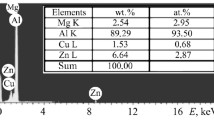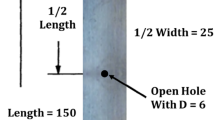Abstract
Acoustic emission during delayed failure of hydrogen-charged low-alloy high-strength steel has been investigated. Tests were carried out at room temperature using standard ASTM three-point bend specimens. It was found that the cumulative acoustic emission counts rose slowly in discrete steps with increasing time in the initial stage of the embrittlement process, whereas it rose rapidly in the later stage prior to fracture. It was also observed that the initial embrittlement phase consisting of microcrack nucleation is characterized by low-amplitude (35–55 dB) signals only, whereas the rapid crack growth region is marked with high-amplitude (60–100 dB) signals. These observations indicate that such a change in the pattern of cumulative counts together with the level of amplitudes of the generated signals can be used to detect the so called “incubation period” for hydrogen embrittlement. This kind of early detection of critical cracks may help towards better fracture control.
Similar content being viewed by others
References
A. R. Troiano, in “Hydrogen Damage”, A Metal Science Source Book, edited by C. D. Beachem (ASM, Metal Park, Ohio, 1977) p. 151.
W. J. Barnett and A. R. Troiano, Trans. AIME209 (1957) 486.
H. H. Chaskelis, W. H. Cullen and J. M. Krafft, ASTM-STP 559 (American Society for Testing and Materials, Philadelphia, 1974) p. 31.
C. E. Hartbower, W. G. Renter, C. F. Morais and P. P. Crimmins, “Acoustic Emission”, ASTM-STP 505 (American Society for Testing and Materials, Philadelphia, 1972) p. 187.
H. L. Dunegan and A. S. Tetelman, Engng Fract. Mech.2 (1971) 387.
W. W. Gerberich and C. E. Hartbower, in “Conference on Fundamental Aspects of Stress Corrosion Cracking”, Ohio State University (National Association of Corrosion Engineering, Houston, Texas, 1969) p. 420.
D. D. Dedhia and W. E. Wood, Mater. Sci. Engng49(3) (1981) 263.
A. Nozne and T. Kishi, J. Acoust. Emission1(1) (1982) 1.
C. R. Heiple and S. H. Carpenter, in “Proceedings of DARPA/AFME Review of Progress in Quantitative Nondestructive Evaluation”, edited by O. D. Thompson and B. R. Thompson (La Jolla, CA, AFWAL-TR-80-4078, 1979) p. 243.
Author information
Authors and Affiliations
Rights and permissions
About this article
Cite this article
Bhattacharya, A.K., Parida, N. & Gope, P.C. Monitoring hydrogen embrittlement cracking using acoustic emission technique. J Mater Sci 27, 1421–1427 (1992). https://doi.org/10.1007/BF00542897
Received:
Accepted:
Published:
Issue Date:
DOI: https://doi.org/10.1007/BF00542897




